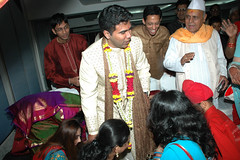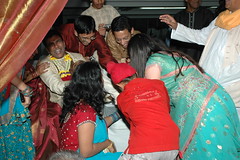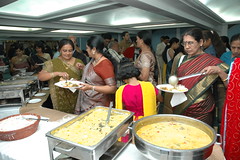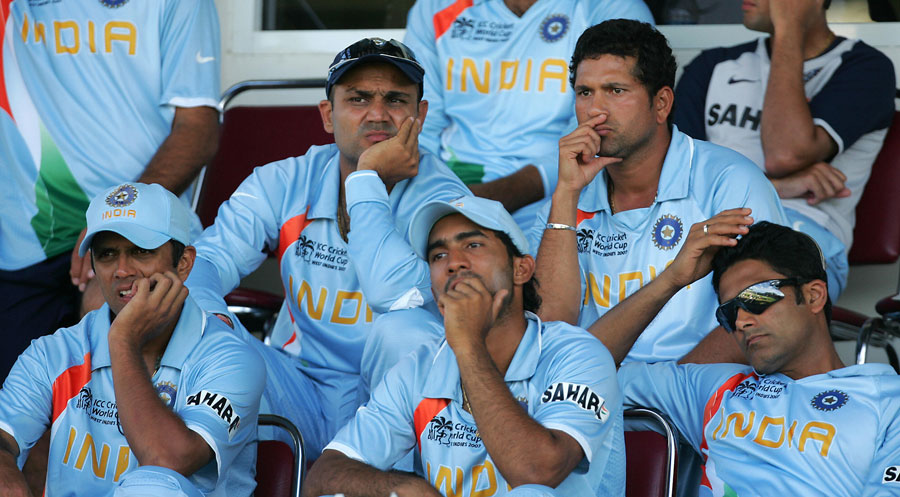After the energy and the euphoria of the cocktail party, the actual wedding ceremony had a hard act to follow. But the toned down affair was probably a welcome change from the partying the previous day. Big W had rightly planned the wedding the next evening. Although other reasons were cited, I have no doubt that this was meant to give all the party-goers some time to recover from their hangovers and get into shape to wish the happy couple during the most important part of the celebrations. An early morning affair - like most South Indian weddings - would certainly have found the wedding hall near empty, the bride's father a little disoriented and the bride groom most certainly missing.
I got up the day of the wedding with severe stomach cramps. Whether it was due to the amount of alcohol consumption or the spicy food in the chaat stall, or as my uncle (who incidentally is a doctor) put it "its just wedding day anxiety" is up to conjucture. However, as I joined the rest of my family at the breakfast table that day, it was with some serious pain, a tinge of self-pity and a bucketload of advice from everyone who was anyone. I probably took 15 pills ranging in color from green to purple, swallowed a few pounds of ayurvedic medicine and worked on a few more strips of pills provided by my previously-mentioned Doctor chithappa.

Big W had scheduled one last lunch for the families to socialize before the evening's wedding. I wore my Kurta Pajama and headed out to the place mentioned in the printout (The 'printout ' was an ode to Big W's organizational skills. It had the schedule, place, timings etc for the entire 3 days and there was a copy in each of the hotel rooms we occupied). I was finally wearing an Indian outfit, and as many kind observers mentioned, was apparently finally looking like a "maapillai" (bridegroom). The lunch was at a classy Gujarati restaurant that was brightly lit and had a tasteful traditional decor. My table was occupied by Ram, Gokul,
ET, SP and my brother
Chandru. Kunal, my would-be brother-in-law took up the other spot. Being a Gujarati, he gave us the nitty gritty on each of the Gujju dishes that were being served on the thali and the assortment of cups on it. We were very grateful to him for this. My stomach cramps came in waves, every 5 minutes or so. But that did not stop me from cleaning up the plate and washing it down with glasses of buttermilk in the intervening periods. There were tentative plans of going shopping with my friends after lunch, but I was still tired out from lack of sleep and my physical ailment. I decided to save my energy for the evening's ceremony and prompty went to sleep as soon as my head hit the pillow in my hotel room.

Evening came and I got up refreshed and feeling much better. I had a quick shower and got into my ornamental Sherwani. Suffice it to say that I was the cynosure of all eyes. Okay, okay, I might be exaggerating a bit here. A sleek black skoda decked up with flowers was waiting to take me to the wedding hall. As I entered, my mother-in-law came to take my aarthi. For some reason she asked me to look up and managed to pull my nose before I even realized it. This was the start of numerous funny customsand rituals that evening. Then, W came out, incredibly beautiful and decked in a breath-taking designer-made '
Lehenga Choli' that probably had a million hand-made decorations every square inch. The combination of jewellery, assortment of bangles and mehendi all combined to make her costume very rich. In short, she was a sight to behold. As she garlanded me and welcomed me into the wedding hall, I couldn't help thinking that I had to be the luckiest guy on the planet. The aunties had somehow managed to outdo their cocktail party costumes from the previous day. There was an eye-popping amount of jewellery on display, probably close to the GDP of a small country in Africa.
For those who are unfamiliar with north indian wedding ceremonies, there is an incredibly funny and totally useless ritual which, for lack of a better title, I will call the "stealing the mojri". Here is a brief description:
1. The groom wears a traditional
mojri (pronounced 'mojdi', a traditional rajasthani shoe not unlike a jodhpuri) with his Sherwani.
2. After he comes to the wedding hall and before he enters the actual ceremony area, he has to take these off (the mojri, not the sherwani!).
3. As soon as he does that, his shoes are stolen by the bride's family, friends, sahelis and an assortment of giggly girls.
4. Since walking around shoeless is considered inappropriate and embarrassing, the groom has to negotiate with the aforementioned gang to get his mojris back. This usually involves a sizeable bribe that gets divided amongst all thed shoe-stealers.

As you can see, this is a very effective money-making scheme. And after the "paisa dedo joothe lelo" song from "
Hum Aapke Hai Kaun", this event has acquired cult status (although Lata Mangeshkar has tried her best to make it sound unappealling!). My dear mother-in-law had warned me about this incident beforehand 'coz she thought I was a poor innocent South Indian boy, a 'bakra' (goat) waiting to be massacred by the evil, guileful and experienced friends of the bride. After considering a variety of alternatives including keeping a spare pair of slippers, I finally decided to rope in the help of my own family and friends - my cousins Swetha and Sumi would be the primary guardians of the shoes, closely supported by SP, Chandru and ET. I promised them riches beyond their wildest dreams (read 'a few hundred rupees each') if they grabbed the shoes before the other party did and manage to guard them with their lives till the ceremony was over.
As I was escorted to the ceremony platform, I realized that W's best friend Rashu had closely followed me and had somehow managed to cordon of my 'shoe'guards. With a very sweet and innocent smile, she was advising me to take off my shoes before getting onto the ceremony platform. I smelt trouble and immediately called for my gang who managed to come just in the nick of time. As I stood there, they started tugging on my mojris. This was quite embarrassing to say the least. I was trying to resist this for a while and even managed a "I've never had so many women at my feet!" that elicited some guffaws. However, very soon it degenerated into a free-for-all with everybody and her sister getting into the act. I could feel people scratching my legs and arms while W's elder sister was busy biting everyone around (I can prod

uce Chandru and ET on the witness stand). For the initial couple of minutes, I was enjoying the attention. But now, I was scared for my life and limb. All I wanted to do was get out of those shoes, but this was proving to be quite difficult what with everyone staking a claim to them. Very soon I was toppled over and managed to land safely on a nearby chair. Eventually, the mojris were gone and I didn't bother to find out where they were. There were more important matters to attend to - my hand was actually bleeding as I entered the ceremony platform. Thankfully, there was a lot of oil and ghee around for the occasion, and the pundit was kind enough to apply some of them on my wound and staunch the flow of blood.
The ceremony itself was short and sweet, punctuated by quite a few misunderstandings as a result of the communication gap between the families. There was one occasion when the pundit thought my family wanted to perform a ritual, while my family was waiting on the pundit. So there they were, both sides patiently waiting for the other side to make a move while W and I sat there scratching our heads. Finally, W, with her usual presence of mind realized what was going on and cleared the air of mystery amidst much amusement. There was also the time when my family wrongly thought it was time to tie the knot and all of them were ready with flowers and rice in their hands. We had to ask them to relax and wait a bit while we finished up with some mantras first. I was happy we didn't bring along our own pundit. Matters would have gotten totally out of hand. There was another occasion when W's mom gives her away to me symbolically. Just when the mom was about to walk away, some aunties asked me to go grab her sari. As inappropiate and completely out of place this sounded to me, I was getting used to these funny rituals. Even warming up to them. So I ran and grabbed her sari's pallu while she tried to run away. Apparently, this was a metaphor for "please don't leave me alone with your daughter" or something to that effect. But the photo did come out quite funny!

Eventually, I tied the knot and walked around the fire with W, and we were declared married. Though this was the exact moment we'd been getting ready for over the last few months, it just sneaked past us. It was not exactly the kind of emotionally overpowering and intense moment that I had been expecting. It really took time to sink in. Following the ceremony, people dispersed to socialize and sample the buffet dinner down the hall. W and I walked around getting everyone's blessings, accepted gifts and posed for photos. Finally, following dinner, we were taken for a special photo op session where we were asked to stand in incredibly filmi poses that would capture this day for eternity.
And that's the story of my Tam Brahm-Sindhi wedding in Gujarat. This was not just a wedding between W and me. Rather, this was (is) a bridge between 2 completely different cultures, attitudes and customs. And it is a testimonial to not only how broad-minded our society has become, but to how delightful the outcome can be when this happens. When we finally wrapped up that evening, W and I were utterly exhausted. We still had a hectic schedule ahead of us. The next day, we were flying to Kerala for a short honeymoon. Following this, a brief stop at Chennai to attend a reception thrown by my parents before flying back to the US the very same night. But all that's probably a story for another day.
PS: If you made it thus far in the post, you might be wondering what happened to my mojris. I had earlier softened Rashu up by showing her my bloody hand and laying the blame squarely on her and her ilk. Then, I sent Chandru and SP to negotiate with her. They must've pretended not to know Hindi or Math or both. But they got me an awesome deal. I'm not going to reveal the amount here and spoil it for future shoe-stealers :-)
 When I read 'The Namesake' by Jhumpa Lahiri a while ago, I was very impressed. She had unerringly captured the emotional turbulence and a sense of not belonging anywhere that millions of immigrants go through. I even placed this book above her Pulitzer prize winning 'Intepreter of Maladies'. However, when I heard that Mira Nair was planning to make a movie out of this, I was a bit skeptical. This was the sort of ficiton that does not lend itself easily to a movie screenplay. There is no plot or twist. No definite start or end. And infact, no moral or message. It was with a sense of curiosity that I went to watch The Namesake this weekend with my wife and a bunch of friends.
When I read 'The Namesake' by Jhumpa Lahiri a while ago, I was very impressed. She had unerringly captured the emotional turbulence and a sense of not belonging anywhere that millions of immigrants go through. I even placed this book above her Pulitzer prize winning 'Intepreter of Maladies'. However, when I heard that Mira Nair was planning to make a movie out of this, I was a bit skeptical. This was the sort of ficiton that does not lend itself easily to a movie screenplay. There is no plot or twist. No definite start or end. And infact, no moral or message. It was with a sense of curiosity that I went to watch The Namesake this weekend with my wife and a bunch of friends.





